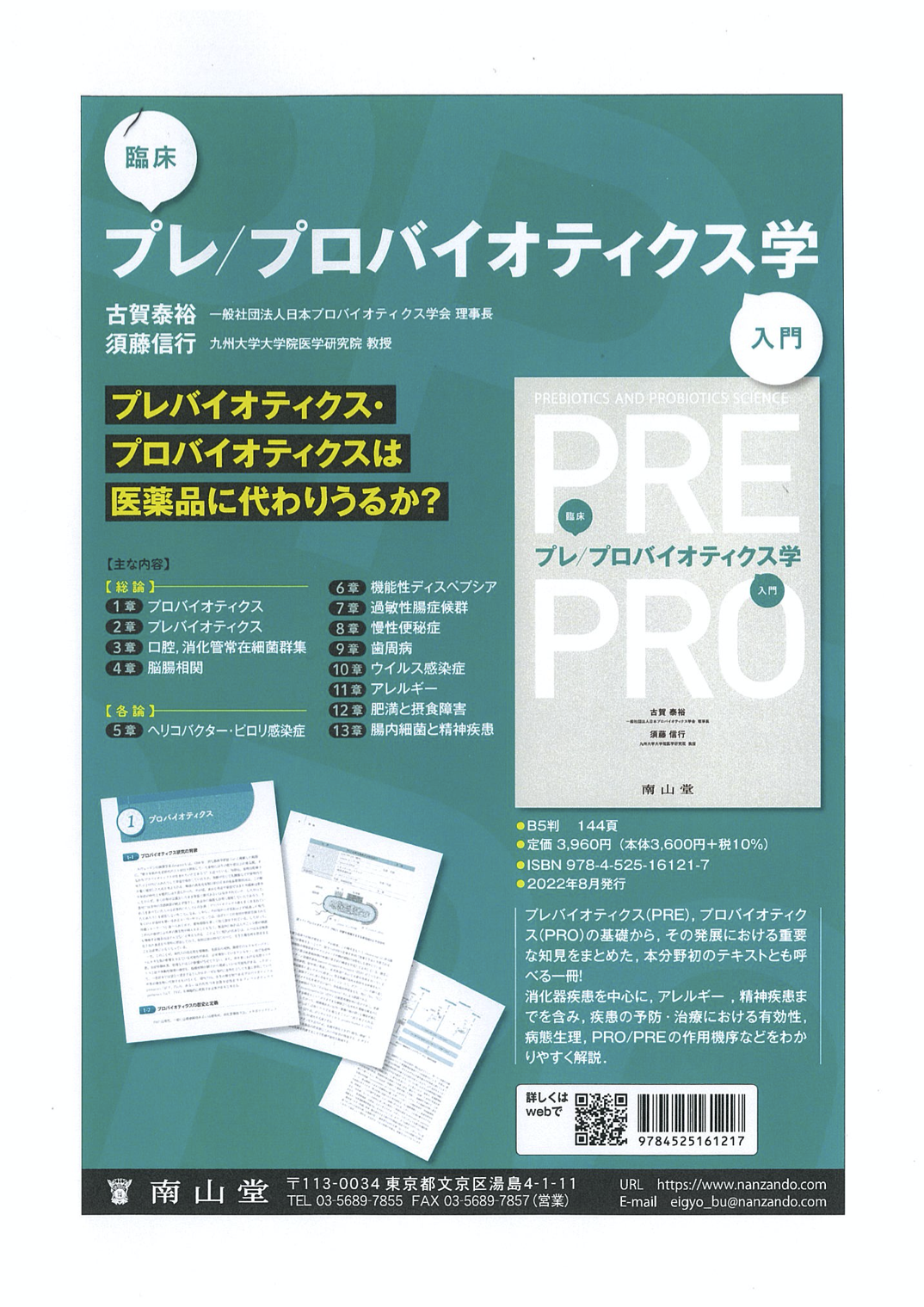論文・刊行物のご案内
単行本
「美味しく食べられる胃を守る」
東海大学消化器内科客員教授、日本プロバイオティクス学会理事長
古賀泰裕
毎日新聞出版社
2025年12月22日発売開始

臨床プレ/プロバイオティクス 学入門
古賀泰裕 須藤信之

「プロバイオティクス・プレバイオティクス学の分野で、初めてとなる入門のための教科書を刊行しました」
「プロバイオティクス物語」
2021年3月、毎日新聞出版社より発行予定。
プロバイオティクス物語
古賀泰裕
日本プロバイオティクス学会理事長
東海大学医学部客員教授
内容
1.序章
2.プロバイオティクスの生い立ち
2.1 メチニコフのこと
2.2 現代プロバイオティクス学の始まり
3.プロバイオティクスのあらまし
4.プロバイオティクスは何にどう効くのか
4.1 ウイルス感染症
4.2 歯周病
4.3 ヘリコバクターピロリ菌感染症
4.4 除菌後胃がん
4.5 機能性ディスペプシア
4.6 便秘
4.7 アレルギー
4.8 肥満
5.プレバイオティクスとは
5.1 なぜプレバイオティクスか
5.2 オリゴ糖
5.3 善玉菌としてのビフィズス菌、酪酸産生菌
5.4 ケストースの可能性
6.終章
本文、約6万5千字、図譜22葉、以下、「序章」を紹介
1.序章
塩野七生氏は、西洋史を題材とした数々の著作を持つ高名な文筆家であり、かつ哲学者でもある。代表作は、何といっても「ローマ人の物語」であろう。壮大な時間と空間からなる題材、精緻な検証、そして非凡な筆力は、この著作を古典的名著に押し上げている。特に、ユリウス-カエサルには作者の思い入れもあって多くの枚数が割かれている。
プロバイオティクスの話をするつもりが、何やら冒頭から「ローマ人の物語」の解説文のようになってしまったが、この作品に言及したのは、その題名の“物語”を拙著のタイトルに転用して、そのスピリットを受け継ぎたかったからである。「ローマ人の物語」執筆にあたっては、塩野氏自らが多くの原著文献を読破することで、古代ローマ帝国の確固とした史実を基盤にした著作に仕上がった。さらに随所に著者固有の哲学が散りばめられているので、読者をぐいぐい引き込み飽かせることがない。歴史専門書であると同時に歴史小説としても読める。
本著「プロバイオティクス物語」を書くにあたっては、「ローマ人の物語」を私淑することで、プロバイオティクスについての知見を平板に並べた無味乾燥な解説文とはならないように、随所に著者の大胆(?)な考えを入れた読ませる作品にしたつもりである。しかし、教養書を目指す以上、記述された内容は質の高い原著論文に基づくものであり、十分に説得力のある見解であると信じる。このような方針のもとにプロバイオティクスを概説した本著を「プロバイオティクス物語」と命名するに至った。
「胃腸革命 乳酸菌LG21:古賀泰裕 著、2000年」(マキノ出版)
「医科プロバイオティクス学:古賀泰裕 編集、2009年」(シナジー出版部)
「アレルギーのない子にするために1歳までにやっておきたいこと :古賀泰裕著、2015年」(毎日新聞出版)
「臨床と研究 特集/プロバイオティクス・プレバイオティクス臨床応用の現状 :古賀泰裕 編著、2018年9月号」(大道学館出版部)
主な英文論文
1. Kabir, A.M.A., Aiba, Y., Takagi, A., Kamiya, S., Miwa, T. and Koga, Y. 1997. Prevention of Helicobacter pylori infection by Lactobacilli in a gnotobiotic model. Gut 41: 49-55.
2. Sudo, N., Sawamura, S., Tanaka, K., Aiba, Y., Kubo, C. and Koga, Y. 1997. The requirement of intestinal bacterial flora for the development of IgE production system fully susceptible to oral tolerance induction. J. Immunol. 159: 1739-1745.
3. Aiba. Y., Suzuki, N., Kabir, A.M.A., Takagi, A. and Koga, Y. 1998. Lactic acid-mediated suppression of Helicobacter pylori by the oral administration of Lactobacillus salivarius as a probiotic in agnotobiotic murine model. Am. J. Gastroenterol. 93: 2097-2102.
4. Kohda, K., Tanaka, K., Aiba, Y., Yasuda, M., Miwa, T. and Koga, Y. 1999. The role of apoptosis induced by Helicobacter pylori infection in the development of duodenal ulcer. Gut 44: 456-462.
5. Wada, T., Aiba, Y., Shimizu, K., Takagi, A., Miwa, T. and Koga, Y. 1999. The therapeutic effect of bovine Lactoferrin in the host infected with Helicobacter pylori. Scand. J. Gastroenterol. 34: 238-243.
6. Takagi, A., Watanabe, S., Igarashi, M., Koike, J., Hasumi, K., Deguchi, R., Koga, Y., and Miwa, T. 2000. The effect of Helicobacter pylori on cell proliferation and apoptosis in gastric epithelial cell lines. Aliment. Pharmacol. Ther.14( Suppl. 1) 188-192.
7. Igarashi, M., Kitada, Y., Yoshiyama, H., Takagi, A., Miwa, T., and Koga, Y. 2001. Ammonia as an accelerator of tumor necrosis factoralpha-induced apoptosis of gastric epithelial cells in Helicobacte pylori infection. Infect. Immun. 69:816-821.
8. Sakamoto, I., Igarashi, M., Kimura, K., Takagi, A., Miwa, T., and Koga, Y. 2001. Suppressive effect of Lactobacillus gasseri OLL 2716 (LG21) on Helicobacter pylori infection in humans.J. Antimicrobia. Chemother. 47:709-710.
9. Sudo, N., Yu. X-N., Aiba. Y., Oyama. N., Sonoda. J., Koga. Y., and Kubo, C. 2002 . An oral introduction of intestinal bacteria prevents the development of a long -term Th2-skewed immunological memory induced by neonatal antibiotic treatment in mice. Clin. Exp. Allergy.32: 1112-1116.
10. Ushiyama A., Tanaka K., Aiba Y., Shiba T., Takagi A., Mine. T., Koga Y. 2003 . Lactobacillus gasseri OLL2716 as a probiotic in clarithromycin-resistant Helicobacter pylori infection J. Gastroenterol.Hepatol. 18 : 986-991.
11. Ishikawa H.,Aiba Y.,Nakanishi M.,Oh-hashi Y.,Koga Y. 2003.Suppression of periodontal pathogenic bacteria in the saliva of humans by the administration of Lactobacillus salivarius TI2711 J. Jpn. Soc. Periodontol. 45 : 105-112.
12. Sudo N., Chida Y., Aiba Y., Sonoda J., Oyama N., Yu X-N., Kubo C., and Koga Y. 2004. Postnatal microbial colonization programs thehypothalamic-pituitary-adrenal system for stress response in mice. J. Physiol. 558. 1 : 263-275.
13. Sudo N., Aiba Y., Oyama N., Yu X-N., Matsunaga M., Koga Y., Kubo C. 2004. Dietary Nucleic Acid and Intestinal Microbiota SynergisticallyPromote a Shift in the Th1/Th2 Balance toward Th1h-Skewed Immunity. Int Arch Allergy Immunol. ; 135 : 132-135.
14. Matsuoka T., Nakanishi M., Aiba Y., and Koga Y. 2004. Mechanism of Porphyromonas gingivalis killing by Lactobacillus salivarius TI2711. J. Jpn. Soc. Periodontol. 46: 118-126.
15. Matsuoka T., Sugano N., Ito K., and Koga Y. 2005. Effect of oral Lactobacillus salivarius TI2711administration on periodontal status and periodontopathic bacteria in subgingival plaque. J. Jpn. Soc. Periodontol. 47: 194-202.
16. Suzuki N., Aiba Y., Takeda H., Fukumori Y., and Koga Y. 2006. Superiority of 1-kestose, the smallest fructo-oligosaccharide, to a synthetic mixture of fructo-oligosaccharides in the selective stimulating activity on bifidobacteria. Bioscience Microflora. 25: 109-116.
17. Tamura A., Kumai H., Nakamichi N., Sugiyama T., Deguchi R., Takagi A., and Koga Y. 2006. Suppression of Helicobacter pylori-induced interleukin-8 production in vitro and within the gastric mucosa by a live lactobacillus strain. J. Gastroenterol Hepatol. 21: 1399-1406.
18. Boonyaritichaikij S., Kuwabara K., Nagano J., Kobayashi K., and Koga Y. 2009. Long-term administration of probiotics to asymptomatic pre-school children for either the eradication or the prevention of Helicobacter pylori infection. Helicobacter 14: 202-207.
19. Mikami K., Takahashi H., Kimura M., Isozaki M., Izuchi K., Shibata R., Sudo N., Matsumoto H., and Koga Y. 2009. Influence of maternal bifidobacteria on the establishment of bifidobacteria colonizing the gut in infants. Pediatr Res 65: 669-674.
20. Shibata R., Kimura M., Takahashi H., Mikami K., Aiba Y., Takeda H., and Koga Y. 2009. Clinical effects of kestose, a prebiotic oligosaccharide, on the treatment of atopic dermatitis in infants. Clin Exp Allergy 39: 1397-1403.
21. Takahashi H., Mikami K., Nishino R., Matsuoka T., Kimura M., and Koga Y. 2010. Comparative analysis of the properties of bifidobacterial isolates from fecal samples of mother-infant psirs. J. Pediatric Gastoroenterology and Nutrition. 51: 653-660.
22. Takahashi H., Nakano Y., Matsuoka T., Kumaki N., Asami Y., and Koga Y. 2011. Role of indigenous Lactobacilli in gastrin-mediated acid production in the mouse stomach. Applied and Environmental Microbiology. 77: 6964-6971.
23. Akama F., Nishino R., Makino S., Kobayashi K., Kamikaseda K., Nagano J., and Koga Y. 2011. The effect of probiotics on gastric mucosal permeability in humans administered with aspirin. Scandinavian Journal of Gastroenterology. 46: 831-836.
24. Nishino R., Mikami K., Takahashi H., Tomonaga S., Furuse M., Hiramoto T., Aiba Y., Koga Y., and Sudo N. 2013. Commensal microbiota modulate murine behaviors in a strictly contamination-free environment confirmed by culture-based methods. Neurogastroenterology & Motility 25:521-528.
25. Shirai T., Suzuki Y., Kamikado K., Koga Y., and Aoki R. 2013. Kestose, a prebiotic fructooligosaccharide, enhances intercellular tight junction recovery via a rho-associated kinase-dependent mechanism in intestinal caco-2 cells. International Journal of Probiotics and Prebiotics. 8: 53-60.
26. Igarashi M., Nagano J., Tsuda A., Suzuki T., Koike J., Uchida T., Matsushima M., Mine T., and Koga Y. 2014. Correlation between the Serum Pepsinogen I Level and the Symptom Degree in Proton Pump Inhibitor-Users Administered with a Probiotic. Pharmaceuticals 7: 754-764.
27. Sadahiro S., Suzuki T., Tanaka A., Okada K., Kamata H., Ozaki T., and Koga Y. 2014. Comparison between oral antibiotics and probiotics as bowel preparation for elective colon cancer surgery to prevent infection: Prospective randomized trial. Surgery 155: 493-503.
28. Matsuoka T., Koga Y. 2014. The differences in the sensitivity of the Porhyromonas Gingivalis fimAgenotypes to a probiotic Lactobacillus strain, LS1, in the oral cavity of patients: double blind clinical trial. International Journal of Probiotics and Prebiotics 9: 4: 135-140.
29. Tsuda A., Suda W., Morita H., Takanashi K., Takagi A., Koga Y., and Hattori M. 2015. Influence of Proton-Pump Inhibitore on the Luminal Microbiota in the Gastrointestinal Tract. Clinical and Translational Gastroenterology 6: e89: doi: 10.1038ctg.2015020.
30. S. Sirilun, Takahashi H., S. Boonyaritichaikij, C. Chaiyasut, P. Lertruangpanya, Koga Y., and Mikami K. 2015. Impact of maternal bifidobacteria and the mode of delivery on Bifidobacterium microbiota in infants. Benefical Microbes 2015 online DOI 10.3920/BM2014.0124
31. A. Takagi, H. Yanagi, H. Ozawa, N. Uemura, S. Nakajima, K. Inoue, T. Kawai, T. Ohtsu and Y. Koga. Effect of Lactobacillus gasseri OLL2716 on Helicobacter pylori-associated dyspepsia: A multicenter randomized double-blind controlled trial. Gastroenterology Research and Practice. 2016. http://dx.doi.org/10.1155/2016/7490452
32. Koga Y, Tokunaga S, Nagano J, Sato F, Konish K, Tochio T, Murakami Y, Masumoto N, Tezuka J, Sudo N, Kubo C and Shibata R. 2016;80:844-851. Age-associated effect of kestose on Faecalibacterium prausnitzii and symptoms in the atopic dermatitis infants. Pediatric Research doi:10.1038/pr.2016.167
33. Nakae H, Tsuda A, Matsuoka T, Mine T, and Koga Y. 2016;3:e000109. Gastric microbiota in the funcional dyspepsia patients treated with probiotic yogurt. BMJ Open Gastro. doi:10.1136/bmjgast-2016-000109
34. Igarashi M, Nakae H, Matsuoka T, Takahashi S, Hisada T, Tomita J, and Koga Y. 2017;3:e000144. Alteration in the gastric microbiota and its restoration by probiotics in patients with functional dyspepsia. BMJ Open Gastro. doi:10.1136/bmjgast-2017-000144
36. Ohtsu T, Takagi A, Uemura N, Inoue K, Sekino H, Kawashima A, Uchida M, and Koga Y. 2017. The ameliorating effect of Lactobacillus gasseri OLL2716 on functional dyspepsia in Helicobacter pylori-uninfected individuals: A randomized controlled study. Digestion 2017;96:92-102.
37. Aoki R, Kamikado K, Suda W, Takii H, Mikami Y, Suganuma N, Hattori M, and Koga Y. 2017. A proliferative probiotic Bifidobacterium strain in the gut ameliorates progression of metabolic disorders via microbiota modulation and acetate elevation. Scientific Reports 7:43522.
38. Tochio T, Kadota Y, Tanaka T, and Koga Y. 2018, Review; 1-kestose, the smallest fructooligosaccharide component, which efficiently stimulates Faecalibacterium prausnitzii as well as bifidobacteria in humans. Foods 2018, 7, 140; doi:10.3390/foods7090140